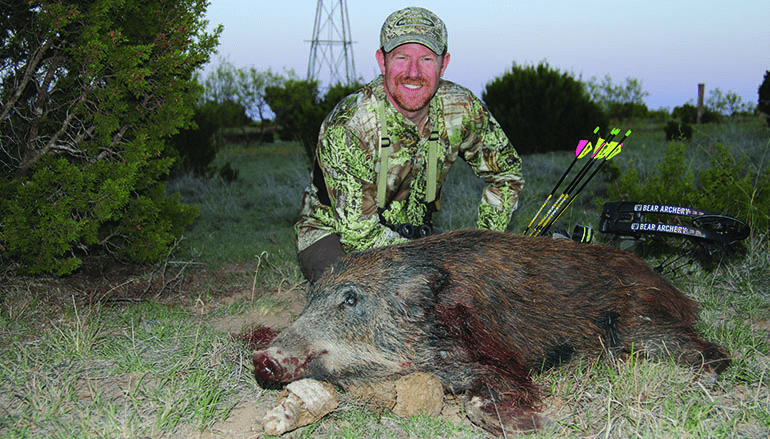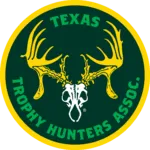
Windmill Hogs
By Brandon Ray
The clues were everywhere. In the muddy run-off pool north of the windmill’s main holding tank laid dozens of blunt-toed tracks. Wallows in sizes ranging from watermelons to bathtubs were along the edge of the muddy pond. On nearby mesquite trees, dried mud caked to the tree’s trunk. On the edge of the rusty holding tank, black wiry hairs stuck to a piece of bent tin. Even a rookie could piece this together as a major hog hangout.
A series of steep, cedar-choked ravines circled the north end of the windmill, more than likely the wild porker’s safety cover. The next step involved hanging a trail camera. Did the hogs visit in daylight or after dark? A trail camera would tell me that information. I scattered corn in the sloppy mud pit and directly in front of the camera. A week later, I checked the camera. A dozen or more hogs used that location. One, a good-sized, spotted boar used it, too. The rest were sows with football-sized piglets. They’d routinely visit at the last hour of the day and randomly throughout the night. On a couple of days, the sows and piglets also hit the water at midday between 12-2 p.m. My best odds were to wait for the right wind direction, back off a safe distance away so the herd wouldn’t smell me, then glass the last hour before dark for my chance to make a stalk. What else is there to do in the off-season?
About Wild Hogs
Texas has more wild hogs than any other state. Of the estimated five million hogs nationwide, Texas is home to an estimated 2.6 million. They do damage to crops, eat expensive supplemental feed intended for cattle or deer, muddy drinking water for livestock, and even wreck golf courses and flower beds when civilization gets too close to hog country. There’s no season or bag limit on them in Texas. While most landowners want cash for hunting deer, an inquiry to hunt destructive pigs might be had for free from a hog-grumpy farmer. The wild hog is a worthy adversary for the bowhunter. His sense of smell is better than a deer. His hearing is keen. Only his vision is less than perfect, but don’t assume he’s as blind as Mr. Magoo. If you remain motionless, he might not pick you off, but hogs are good at spotting movement. If they sense any hunting pressure at all, they become nocturnal. Did I mention their sense of smell is on a superhero-like level?
Archery Tackle
Big hogs can be tough to bring down with archery tackle. Their hair and hide is thick and their bone structure is stout. The best shot is a broadside or slight quartering away with an arrow placed through both lungs. Personally, I prefer fixed blade broadheads for dependable penetration on tough boars. A few current favorites include the 4-blade Slick Trick, 3-blade NAP Hellrazor, 3-blade NAP Thunderhead Razor, and the cut-on-contact Solid Legend. I prefer arrows that weigh at least 400 grains out of my compound, 500 grains or more from my traditional bow. I’ve had good success with the 2-blade Silver Flame, 3-blade VPA Terminator and the 3-blade Woodsman broadhead on the end of heavy carbon arrows out of my longbow or recurve. Study a hog anatomy photo so you’ll know right where to aim to hit the heart or lungs. Hogs always gravitate towards wet places. Their hairy bodies need cool water and mud to lower their body temperature. It makes sense the hotter the weather and the drier the landscape (drought) the more valuable a good water source becomes to a hog hunter. Trail cameras can nail down what time you should be there. I’ve found the best times during hot weather are midday and the last two hours before dark.
Hunting Muddy Hogs
A couple years ago, I found hog sign littering a familiar windmill I hunt every year for doves. A beat-down game trail led under a barbed wire fence. Long, stiff brown hairs were caught in the bottom strand of barbed wire. At the pond, there were wallows in the mud and big tracks. A trail camera strapped to the trunk of an ancient poplar tree proved what I suspected: a herd of hogs frequented the pond at the last hour of the day. A few days later, when the wind was out of the south like it needed to be, my friend Kyle Barbour guarded the pond. He sat 100 yards north of the pond dam, waiting and watching. At sunset, he heard hogs grunting and fighting. Then he heard splashing and squealing. A herd of wandering hogs that finds water is seldom quiet. Kyle nocked an arrow and eased over the pond’s dam. There in the mud were a dozen hogs. Kyle’s first arrow blasted through a black sow at 20 yards. She ran like a bank robber. The other ones hesitated long enough for Kyle to fire a second shot, then it was chaos. The hogs ran towards the trail on the fence, the bottom strand of wire vibrating and singing like an out-of-tune guitar when the dozen hogs went under it single file.
Back to The Beginning
I had plenty of evidence the south windmill was worth hunting. The first evening, I backed off 60 yards from the mud hole with the wind in my favor. I wanted to be even farther away to avoid hogs going behind me. But the cedars are so thick there, any farther away and you can’t see the pond. It was sunset, the blades on the windmill groaning and spinning, just enough sound to cover a short stalk if needed, when I heard something behind me. All I heard were two very distinct, loud “sniffs,” similar to the sound of an elephant’s trunk inhaling a peanut. Thirty seconds later I heard it again, this time followed by the swoosh of a cedar branch as an animal ran past it. I was busted. Hunt over. Did I mention there’s no fooling a hog’s nose?
The Next Time
I let that spot rest a week before trying it again. The next time, the wind was steadier and the day had been hot, 85 degrees. I waited 60 yards away, the windmill’s blades spinning and yawning in the blue sky. It was 7:30 p.m. when it happened. Suddenly, there they were—15 hogs charging into the muddy slop. Hogs of every color: brown, black, spotted and red. On nimble feet, I dodged from cedar to cedar, closing the gap with an arrow nocked. A brown sow was rooting her snout in the mud at 20 yards, her body angling slightly away. My olive green Bear BR33 bow came back to my cheek smoothly, the string bent and barely touching my nose, my eye in the peep. My 410-grain Victory carbon arrow hit mid-body, but penetrated forward through the offside front shoulder taking out both lungs. The rest of the herd stampeded past me. A short 35 yards from the mud hole I found the brown hog dead



